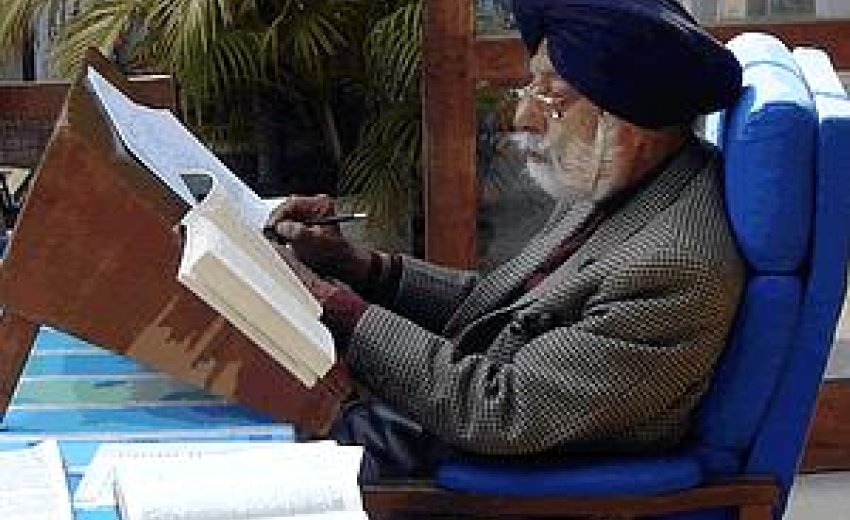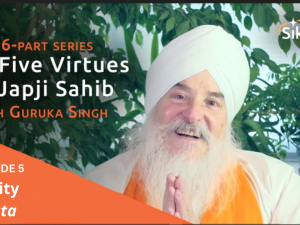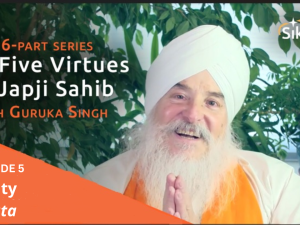Some Intellectual Gymnastics
We invite you to join us on a zig-zag journey through the writings of the Sikh diaspora. There has been, of late, an explosion of voices where just a few decades ago there were practically none at all.
Just over 45 years ago there were Sikhs in the United States but they were rarer than hen’s teeth. One of us (IJS) met one on a New York street and inevitably we fell to talking about how few we were and how little the host community here – largely Judeo-Christian – knew anything about us.
This Sikh was a well settled scientist and entrepreneur with a vision of building a library on Sikhism in California. Easily done, he said. He claimed to have collected all the books in English that existed on Sikhs and Sikhism and, according to him, there were no more than 300. He would get them bound in leather and that would be the definitive library on Sikhism in the new world.
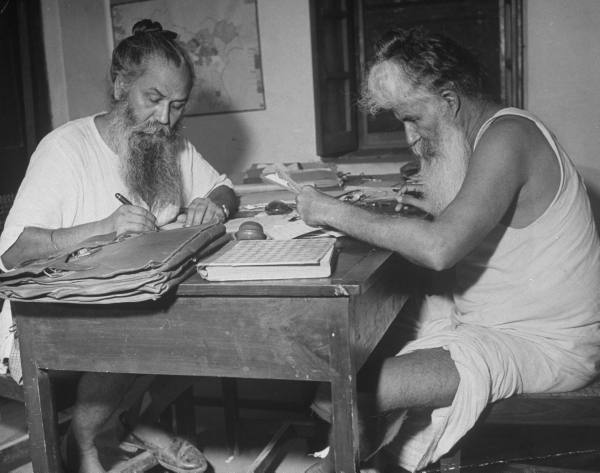 This was astounding; a
500 year old tradition with a new image and a progressive ideology, and all it
had was 300 books to offer the world?
The idea bugged me but was not easily countered; it certainly didn’t
deserve celebration.
This was astounding; a
500 year old tradition with a new image and a progressive ideology, and all it
had was 300 books to offer the world?
The idea bugged me but was not easily countered; it certainly didn’t
deserve celebration.
However, in North America, a land with less than 300 years as a nation and a fickle memory, we Sikhs have a relatively formidable history; for instance, Sikh workers helped build the Panama Canal in 1903-04. But effectively as a community here we are only about 40 years old. We really are the new kids on the block.
Yet, time never stands still. The last half century has caught us in a revolution and we are a-swirl in it; we’ve got the tiger by the tail.
A new and vocal generation of wired and connected Sikhs has arisen and they have have created a virtual university without walls. But these matters are not always so easy to measure. For instance neither of the two of us authors is young but one (GS) spans the age divide with nary a hitch as the CEO of SikhNet and much of his literary output is for the computer savvy readership while the other (IJS) has a deceptively significant presence on the Internet but the bulk of his work really shows a more sizeable paper trail.
A rapidly growing family of Sikh bloggers share their insights and life experiences on the path of Sikhi with the world at large and they have provided much inspiration to many people, especially the younger generation. The beauty of blogging, as compared to more formal or academic styles of writing is its un-self-conscious honesty, directness and immediacy. Blogging makes the writer vulnerable, and in that vulnerability a uniquely intimate connection to the reader is engendered.
Bloggers whose insights
stand out immediately include Harmeet Singh who describes his blog “Journey of
a Sikher” (http://princeofpunjab.blogspot.com)
as “A collection of thoughts, reflections & experiences documented for my
children Baltej, Himmat & Avtar;”
Manvir Singh, http://manvirsingh.blogspot.com/ Gurumustuk Singh, the CTO of SikhNet, whose “MrSikhnet blog (www.mrsikhnet.com) shares his Sikhi through
his everyday experiences with his family and Sangat; “Maple Leaf Sikh” (http://www.mapleleafsikh.com/) who
describes his insightful blog as “The random musings of a second generation
Sikh-Canadian;” Rubin Paul Singh’s “Spirit of the Sikh” blog http://spiritofthesikh.com/ , Ek Ong
Kaar Kaur’s blog “Inspire Yourself! (http://ekongkaark.com/)
which brings a woman’s voice that has exquisite insight along with great
personal honesty The UK-based Langar
Hall (http://thelangarhall.com/ ) which
manages to be a progressive, outspoken, inspiring and provocative voice of
second-generation UK Sikh youth; “ the f word” (http://www.thefword.org.uk/index)
embodying the voices of young UK feminists and Rupinder Mohan Singh’s “American
Turban” blog (http://americanturban.com)
which easily and compassionately spans the “generation gap” and expresses the
life and experiences of a second generation Sikh in the USA. This is by no
means an exhaustive list and it represents simply a few that come to mind.
Search online for “Sikh bloggers” and you will find many more.
Today’s Sikh youth live their lives woven into the constant presence of social media, mainly Facebook, Twitter, Instagram and Tumblr, which serve to provide connection as well as inspiration, real-time presence and community, things that are essential to everyone, but especially youth. Though not at all what could be described as reasoned or thought-out writing, Tumblr sites like “Turbaned Sikh Women” (http://turbanedbeauties.tumblr.com/) provide inspiration to a new generation of young Sikh women.
If the first 500 years of Sikhi produced only 300 books in English, the intervening 50 must have produced better than that number in just the diaspora – not counting what is penned by India-based writers.
Significantly, most writing in English from India continues to be by university-based academicians, but this is not quite true of the diaspora-based writers. Here, there are relatively few academically trained writers on Sikhism, though the number is increasing exponentially. These are scholars with doctoral degrees in some aspect of Sikhi, no matter how esoteric. Most are of Sikh background. There are also a few whose research is Sikhi related but who come to us from Judeo-Christian heritage. Thus they are in the footsteps of Ernst Trump, Max Arthur MaCauliffe, Hew McLeod, Jerry Barrier, Christopher Shackle, and others, but not always of the same bent in thinking.
These scholars are trained outside India, largely in the United States and the UK. We point to Gurinder Singh Mann, Pashaura Singh, Nirvikar Singh and Jaideep Singh Alag in the California universities; Arvindpal Singh Mandair at University of Michigan, and Balbinder Singh Bhogal at Hofstra –a university that boasts of a second Sikhi-related Chair in Gurbani Sangeet headed by Francesca Cassio. Then there is Nikky Guninder Kaur at Colby College in Maine whose research and writings are mostly in Sikh studies while she occupies an endowed chair in religious studies; Harpreet Singh, the newly minted PhD in Sikh studies from Harvard, and Simranjeet Singh who is near the tail end of completing his doctoral training at Columbia University. There are a few in Europe as well but we do not list them here today.
We name these formally trained scholars of Sikhi in North America since they are products of the Sikh diaspora. A couple of caveats: Keep in mind the unpardonable probability, nay, certainty that we are leaving out some. Also that our connecting them to their work might pigeonhole them or their sub-specialty and that would not be fair. Their writing is largely academic and their interaction is often with other academicians, so they are in a special category.
Our purpose today is simply a brief exploration of how far the explosion of productive writing on Sikhi has happened in only four decades since the minuscule reality of only 300 books, and how this reflects the realities of today’s electronic information-based lifestyle and the grass roots of Sikh communities outside Punjab.
There are just as many Sikhs who have spent their whole lifetime in the diaspora – and the number is growing – who have gotten the bug of exploring Sikhi. These lay Sikhs are not formally trained in Sikhi nor religious studies; they are professionals in medicine, engineering, law, computer science, investment banking, management, or the art and science of making money but they are also actively involved in Sikhi – who we are, what we are and why we are the way we are.
What occupy them are matters of our sense of self and how we relate to our non-Sikh neighbors; how we strive for an equal place at the table of society and how we raise our families in Sikhi. What fascinates us today is that the majority of the writers in English are lay Sikhs with a smorgasbord of training and backgrounds.
Sikhs outside India have also tried their hand at publishing periodicals, newsletters, newspapers, journals and magazines, but with mixed results. Books meanwhile are flying off the presses. There was a time that we could boast of knowing each book and/or its author as it was released and we would quickly acquire a copy, but no longer.
Most of these lay writers, a category to which both of us happily belong, concern themselves with issues of everyday life as a Sikh and not as much with parsing esoteric doctrinal or historical detail, although there are ample exceptions to that as well.
Many have published books, some printed outside India and some in India, but written primarily by and for people with lives outside the Indian subcontinent. Those who write on the Web are writing for a global readership beyond geographical boundaries. This means that their concerns are different, their outlook has changed, how they seek clarification and source material or methodology for resolving issues is different. They are culturally different and so is their outlook.
This shouldn’t be alarming. Religions, after all, are practiced within an existing cultural context, social structure, societal values and norms, and not in a vacuum. These realities can be and are transforming; they alter practices, influence traditions, language and music, even mores.
We look at books on and about Sikhi in the diaspora and some of the titles are meant to hit you in the solar plexus -- Square Pegs Round Holes, One Coin Two Sides, Sikhism – Points to Ponder. All three are by a practicing neurologist, Jaswant Singh Sachdev; clearly the emphasis is less on some convoluted matters of doctrine but, as T.S. Eliot would say, on the “cunning passages and contrived corridors of history.”
Whether it is as “Connecting the Dots in Sikh History” by Harbans Singh Noor or “Lost in History” by Gunisha Kaur, the direction is clearly less on arcane matters of parsing faith but often on issues that frequently split the community, matters that highlight conflict with our host society of non Sikh neighbors in interpretation or practice.
In a nutshell the idea is being able to define our traditions and practice such that they help us to achieve an equal place at the table of this society
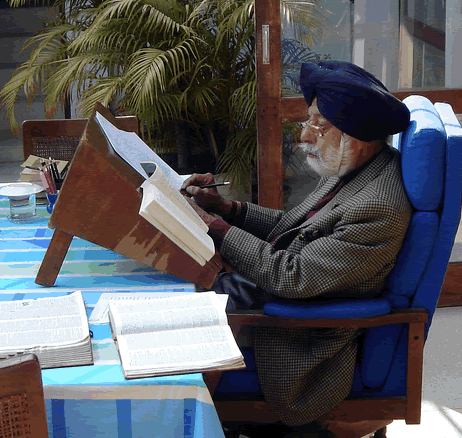 By this reasoning then we
would label the many authors that have emerged in the diaspora as “Public
Intellectuals.” These are people who
write not in the areas of their training and specialty but range widely over
the cultural and historical landscape to define the points of convergence and
conflict between Sikhs and their host society.
By this reasoning then we
would label the many authors that have emerged in the diaspora as “Public
Intellectuals.” These are people who
write not in the areas of their training and specialty but range widely over
the cultural and historical landscape to define the points of convergence and
conflict between Sikhs and their host society.
In an incomplete list we would then include many: Harbans Singh Noor, Jaswant Singh Sachdev, Gurpal Singh Bhuller, Ranbir Singh Sandhu, Sukhraj Singh Dhillon, Hakam Singh, Harbans Lal, Jaspall Singh Mayell, Davinder Singh Chahal; Harinder Singh, Ravinder Singh Taneja, Madho Singh, Yultanand Singh; Jaswant Singh Neki and Hardev Singh Virk (both now in India), Rawel Singh, Kulbir Singh Thind; UK based Sukhbir Singh Kapoor, Amandeep Singh Madra, Gurmukh Singh and Kanwar Ranvir Singh; Shanti Kaur, Manjyot Kaur, Gunisha Kaur, Gurmeet Kaur, Inni Kaur, Anju Kaur, Neha Gohil and Jessi Kaur; as well as both the authors of this little essay. Guruka Singh and Shanti Kaur come to us from the movement founded by the late Harbhajan Singh Yogi and represent home grown converts to Sikhi with no cultural or ancestral ties to Punjab; they have a ton of publications and have also created SikhNet, the most successful Sikh website.
Keep in mind that we have deliberately not listed these heavyweights in any order. We are also leaving out any and all with serious academic training in Sikhi. A fair number of women are listed and that’s good. These writers present spirited and wide-ranging viewpoints. Keep in mind also that so far we have focused largely on book, print and writing for the Web. We are ignoring movie-making and that is a significant omission which we hope to address in a future essay.
Some like Guruka Singh, T. Sher Singh, Kanwar Ranvir Singh and many others have written less in books and paper journals and more for the Web. A growing number of young Sikhs write and reason convincingly in new media; we include here the founder-operators of the myriad sites that we see every day, like SikhNet, Sikh Network News, Sikh Point, Gurmat Learning Zone, Sikh Diaspora, Sikhchic, Sikh Philosophy Network, and so many more. Translations of Sikh history, traditions and Gurbani are easily available at the click of a mouse on Sikhi-to-the-Max https://www.sikhitothemax.org/ and other websites; plenty of Gurbani and Sikhi search engines such as www.srigranth.org can be easily found as well.
As we suggested earlier these are some of our public voices. We await the next step – the emergence of minds that are deeply grounded in Sikhi while at the same time, like Amitai Etzioni, Noam Chomsky, Carl Sagan, Stephen Hawking and Bertrand Russell, among others, can engage us on a wide variety of matters from the nature of God, Evolution, Creation to Bioethical issues like cloning, environment, and the fundamentals of ethics, morality, reason and faith.
This list is no way near completion and will never be, since it is constantly evolving. Publishing is not what it once was, and it seems that it is not a bad thing at all. Now the question is, will the message of Sikhi flow back from the diaspora into India? And wouldn’t that be like carrying coal to Newcastle?
Sometimes we worry if the Web will even let the “paper culture” exist. But hope springs eternal and we remain optimistic. We just need to expand our idea of publications to include all the communication channels from paper to emerging media.
Keep in mind that the culture of books is changing and diminishing at an astonishing rate. But we take courage and hope from the New York based Strand Book Shop that used to boast of eight miles of books and has now extended its claim to 18 miles.
It is past time to dream of a diaspora-based powerful Sikh publishing house equipped and armed with the right infrastructure for vetting manuscripts, editing, production and placing of publications in the right outlets.
Diaspora has been good to Sikhs and Sikhi. It has released tremendous energy and imagination and that’s what Sikhi is all about.
By I.J. Singh & Guruka Singh
August 14, 2013

